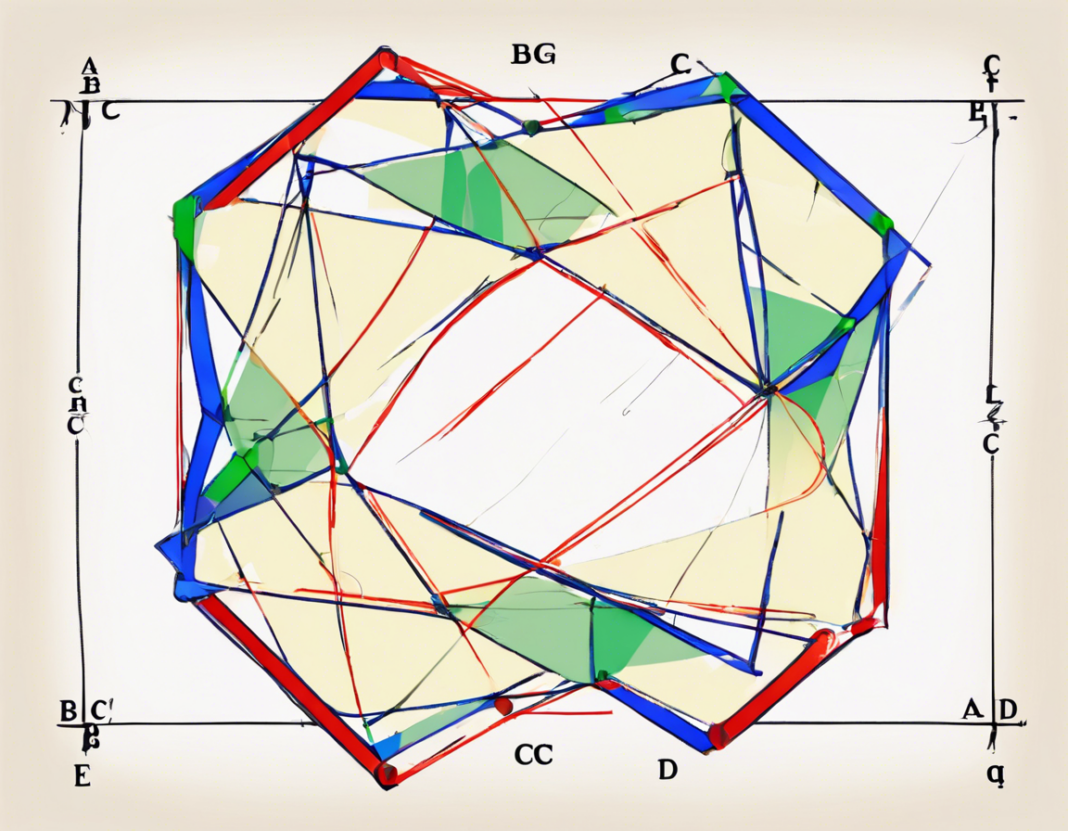Cyclic quadrilaterals are fascinating geometrical figures that have properties worth exploring. Before delving into the depth of this topic, let’s define what a cyclic quadrilateral is. A cyclic quadrilateral is a four-sided polygon where all four vertices lie on a single circle, known as a circumcircle. Understanding the properties and theorems associated with cyclic quadrilaterals can be beneficial for both students and enthusiasts of geometry. In this article, we will explore the properties of cyclic quadrilaterals, the theorems applicable to them, and how they are applied in problem-solving.
Properties of Cyclic Quadrilaterals
-
Sum of Opposite Angles: The opposite angles of a cyclic quadrilateral are supplementary, meaning that the sum of each pair of opposite angles is equal to 180 degrees.
-
Equal Opposite Angles: In a cyclic quadrilateral, the opposite angles are equal. Hence, if one pair of opposite angles is (a) and (b), then the other pair will be (a) and (b) as well.
-
Equal to Half the Sum of the Opposite Angles: The measure of each angle in a cyclic quadrilateral is half the sum of the other two opposite angles.
-
Diagonals and Angles: The line joining the midpoints of the diagonals of a cyclic quadrilateral are parallel to each other and bisect each other.
-
Inscribed Angle Theorem: When you draw any two chords within a circle, the angle they subtend at the center is equal to the sum of the two angles they subtend at the circumference. This theorem is also known as the inscribed angle theorem.
-
Ptolemy’s Theorem: Ptolemy’s theorem states that in a cyclic quadrilateral, the product of the diagonals is equal to the sum of the products of the two pairs of opposite sides.
-
Miquel’s Theorem: If you draw the circumcircles of four triangles formed by one vertex of the cyclic quadrilateral and the three other vertices, these circles will intersect at a single point known as the Miquel point.
Theorems of Cyclic Quadrilaterals
-
Brahmagupta’s Formula: Brahmagupta’s formula states that the area of a cyclic quadrilateral can be calculated using the lengths of the sides and the semiperimeter of the quadrilateral.
-
Ptolemy’s Theorem: This important theorem provides a relationship between the sides and diagonals of a cyclic quadrilateral, as mentioned in the properties section.
-
Concyclic Points Theorem: If four points are concyclic, that is if they lie on a common circle, then the six line segments that can be drawn joining them in threes are concurrent. This theorem has significant applications in the study of cyclic quadrilaterals.
-
Miquel’s Theorem: The Miquel point, as described earlier, is an essential concept in the study of cyclic quadrilaterals. This theorem is significant in showing the relationship between the circles inscribed in the triangles formed by the cyclic quadrilateral.
-
Carnot’s Theorem: Carnot’s theorem relates the radii of three circles that are pairwise externally tangent to a fourth circle. This theorem has applications in cyclic quadrilaterals when dealing with the circles inscribed within the quadrilateral.
Application in Problem-Solving
Cyclic quadrilaterals are commonly used in geometry problems. They provide a rich ground for theorems to be applied and solutions to be derived. When faced with a problem involving a cyclic quadrilateral, students can utilize the properties and theorems mentioned earlier to deduce conclusions and solve for unknown angles or side lengths.
Let’s illustrate this with an example problem:
Problem: In a cyclic quadrilateral, the measure of one angle is 80 degrees, and an opposite angle is 100 degrees. Find the measures of the other two angles.
Solution:
Using the property that the opposite angles in a cyclic quadrilateral are supplementary, we find:
(Measure\; of\; 3^{rd}\; angle = 180 – 80 = 100 \; degrees)
(Measure\; of\; 4^{th}\; angle = 180 – 100 = 80 \; degrees)
Therefore, the measures of the other two angles are 100 degrees and 80 degrees, respectively.
FAQs about Cyclic Quadrilaterals
-
What is the definition of a cyclic quadrilateral?
A cyclic quadrilateral is a four-sided polygon in which all four vertices lie on a common circle, known as the circumcircle. -
How are opposite angles related in a cyclic quadrilateral?
The opposite angles in a cyclic quadrilateral are equal and supplementary, meaning they add up to 180 degrees. -
What is Ptolemy’s theorem, and how is it used in cyclic quadrilaterals?
Ptolemy’s theorem states that in a cyclic quadrilateral, the product of the diagonals is equal to the sum of the products of the two pairs of opposite sides. It is often used to establish relationships between the sides and diagonals of the quadrilateral. -
What is the Inscribed Angle Theorem, and how does it relate to cyclic quadrilaterals?
The Inscribed Angle Theorem states that the angle subtended by an arc on a circle is half the central angle that the same arc subtends. This theorem is significant in understanding angles within cyclic quadrilaterals. -
How can cyclic quadrilaterals be used in real-world applications?
Cyclic quadrilaterals can be used in various fields such as architecture, design, and engineering where geometric principles are applied to solve problems related to angles and shapes.
Understanding the properties and theorems of cyclic quadrilaterals can not only enhance one’s knowledge of geometry but also sharpen problem-solving skills. By grasping the intricacies of these figures, individuals can navigate complex geometric scenarios with ease and confidence. Whether you are a student exploring geometry or a geometry enthusiast delving into advanced topics, cyclic quadrilaterals offer a playground of geometric wonders to explore and understand.


